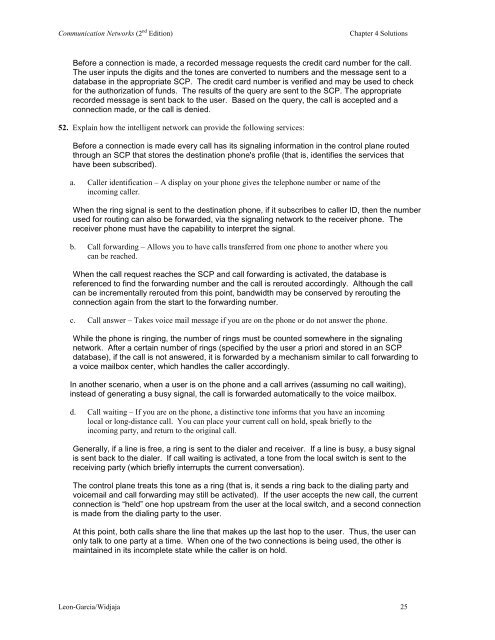Solutions to Chapter 4 - Communication Networks
Solutions to Chapter 4 - Communication Networks
Solutions to Chapter 4 - Communication Networks
Create successful ePaper yourself
Turn your PDF publications into a flip-book with our unique Google optimized e-Paper software.
<strong>Communication</strong> <strong>Networks</strong> (2 nd Edition)<br />
<strong>Chapter</strong> 4 <strong>Solutions</strong><br />
Before a connection is made, a recorded message requests the credit card number for the call.<br />
The user inputs the digits and the <strong>to</strong>nes are converted <strong>to</strong> numbers and the message sent <strong>to</strong> a<br />
database in the appropriate SCP. The credit card number is verified and may be used <strong>to</strong> check<br />
for the authorization of funds. The results of the query are sent <strong>to</strong> the SCP. The appropriate<br />
recorded message is sent back <strong>to</strong> the user. Based on the query, the call is accepted and a<br />
connection made, or the call is denied.<br />
52. Explain how the intelligent network can provide the following services:<br />
Before a connection is made every call has its signaling information in the control plane routed<br />
through an SCP that s<strong>to</strong>res the destination phone's profile (that is, identifies the services that<br />
have been subscribed).<br />
a. Caller identification – A display on your phone gives the telephone number or name of the<br />
incoming caller.<br />
When the ring signal is sent <strong>to</strong> the destination phone, if it subscribes <strong>to</strong> caller ID, then the number<br />
used for routing can also be forwarded, via the signaling network <strong>to</strong> the receiver phone. The<br />
receiver phone must have the capability <strong>to</strong> interpret the signal.<br />
b. Call forwarding – Allows you <strong>to</strong> have calls transferred from one phone <strong>to</strong> another where you<br />
can be reached.<br />
When the call request reaches the SCP and call forwarding is activated, the database is<br />
referenced <strong>to</strong> find the forwarding number and the call is rerouted accordingly. Although the call<br />
can be incrementally rerouted from this point, bandwidth may be conserved by rerouting the<br />
connection again from the start <strong>to</strong> the forwarding number.<br />
c. Call answer – Takes voice mail message if you are on the phone or do not answer the phone.<br />
While the phone is ringing, the number of rings must be counted somewhere in the signaling<br />
network. After a certain number of rings (specified by the user a priori and s<strong>to</strong>red in an SCP<br />
database), if the call is not answered, it is forwarded by a mechanism similar <strong>to</strong> call forwarding <strong>to</strong><br />
a voice mailbox center, which handles the caller accordingly.<br />
In another scenario, when a user is on the phone and a call arrives (assuming no call waiting),<br />
instead of generating a busy signal, the call is forwarded au<strong>to</strong>matically <strong>to</strong> the voice mailbox.<br />
d. Call waiting – If you are on the phone, a distinctive <strong>to</strong>ne informs that you have an incoming<br />
local or long-distance call. You can place your current call on hold, speak briefly <strong>to</strong> the<br />
incoming party, and return <strong>to</strong> the original call.<br />
Generally, if a line is free, a ring is sent <strong>to</strong> the dialer and receiver. If a line is busy, a busy signal<br />
is sent back <strong>to</strong> the dialer. If call waiting is activated, a <strong>to</strong>ne from the local switch is sent <strong>to</strong> the<br />
receiving party (which briefly interrupts the current conversation).<br />
The control plane treats this <strong>to</strong>ne as a ring (that is, it sends a ring back <strong>to</strong> the dialing party and<br />
voicemail and call forwarding may still be activated). If the user accepts the new call, the current<br />
connection is “held” one hop upstream from the user at the local switch, and a second connection<br />
is made from the dialing party <strong>to</strong> the user.<br />
At this point, both calls share the line that makes up the last hop <strong>to</strong> the user. Thus, the user can<br />
only talk <strong>to</strong> one party at a time. When one of the two connections is being used, the other is<br />
maintained in its incomplete state while the caller is on hold.<br />
Leon-Garcia/Widjaja 25







